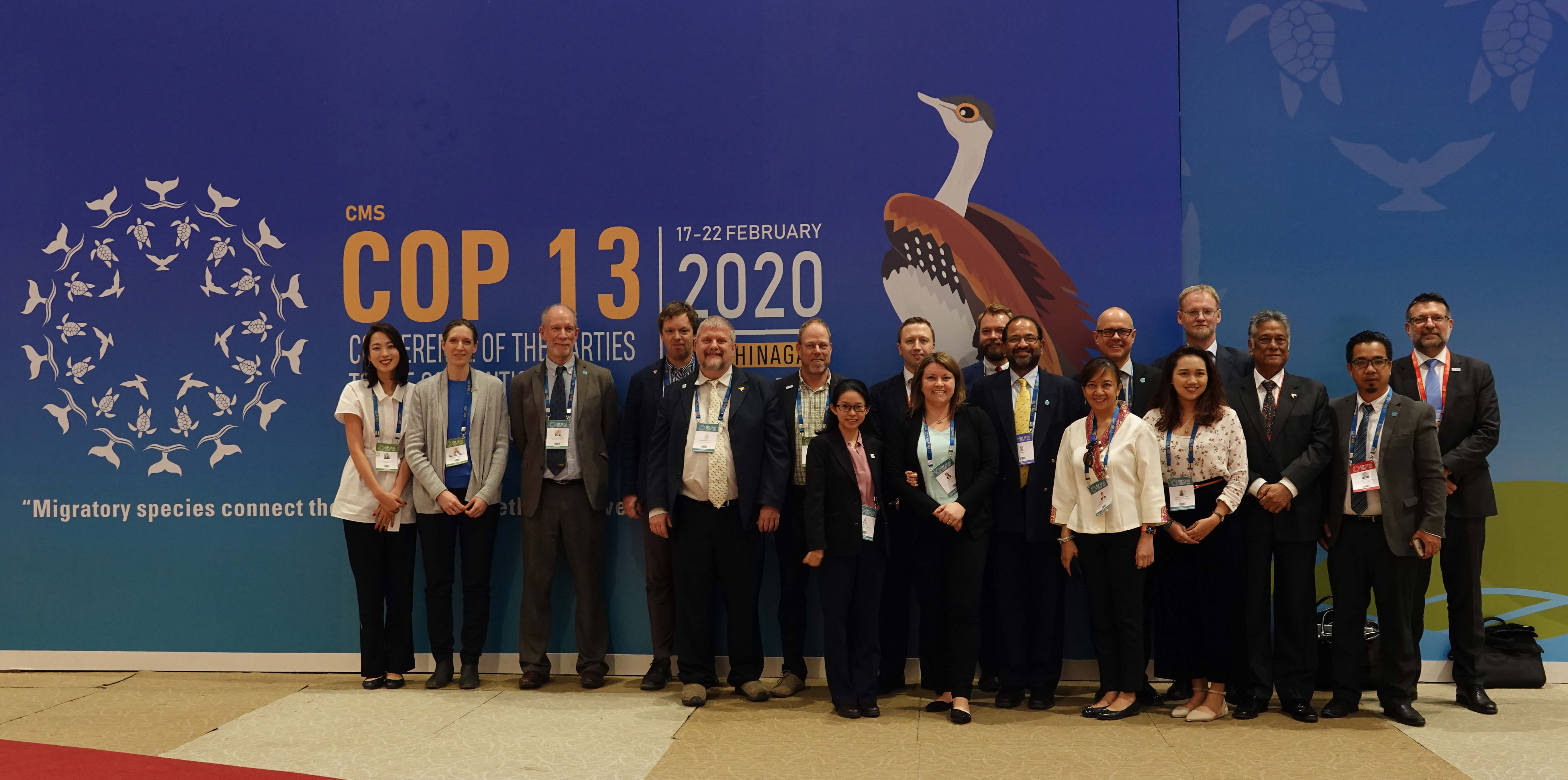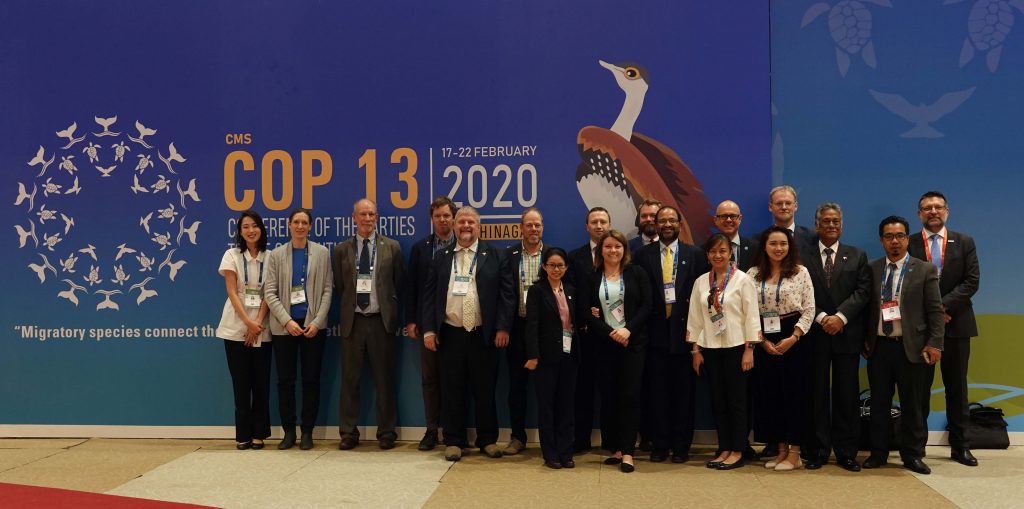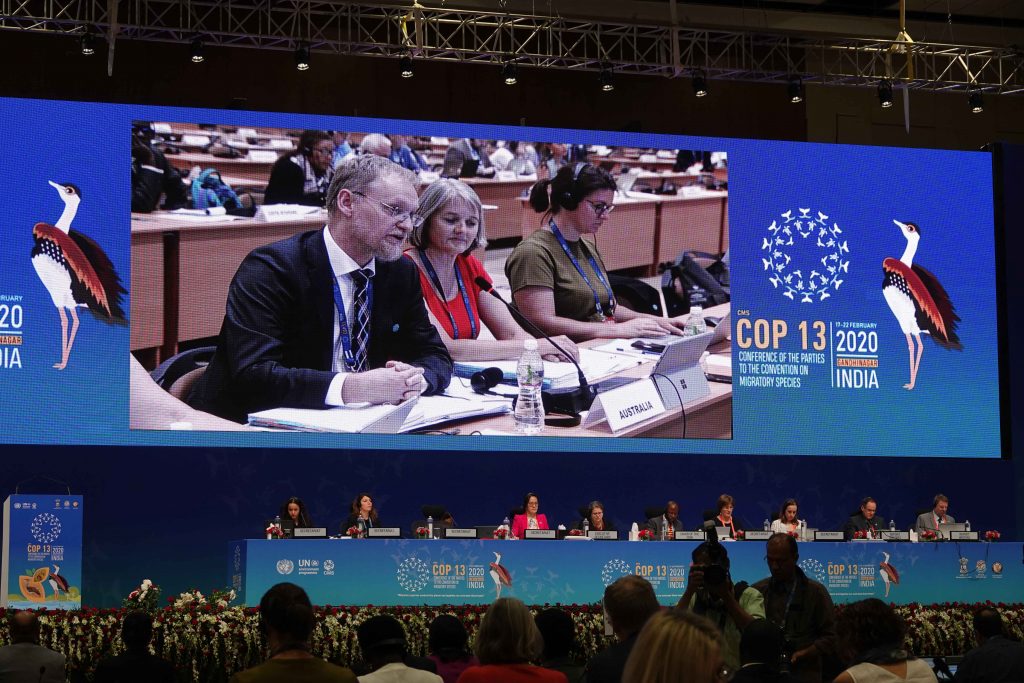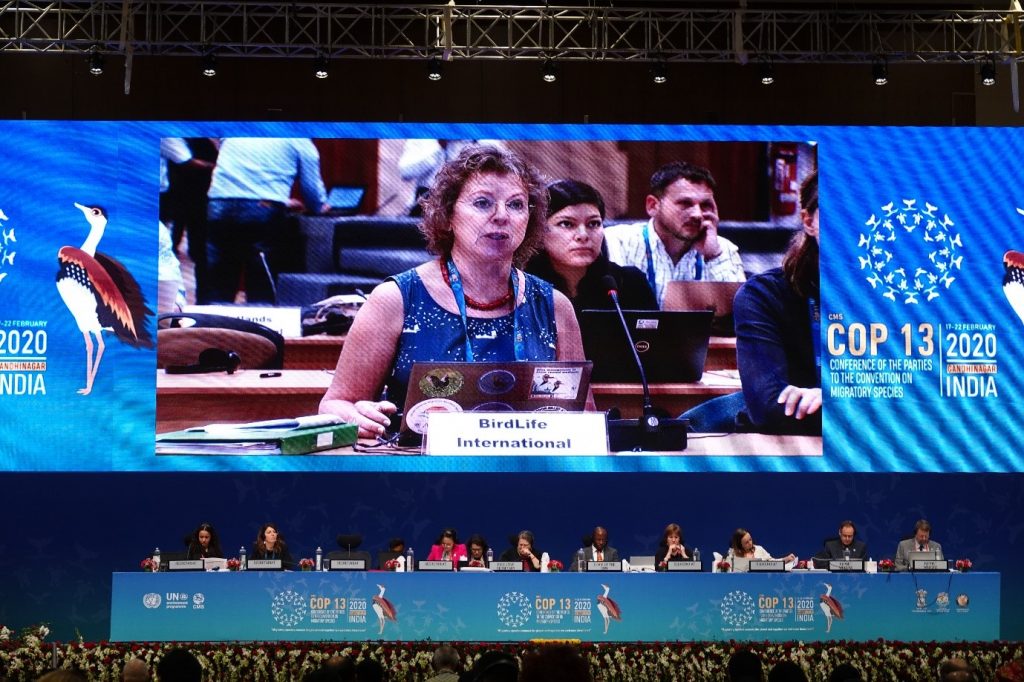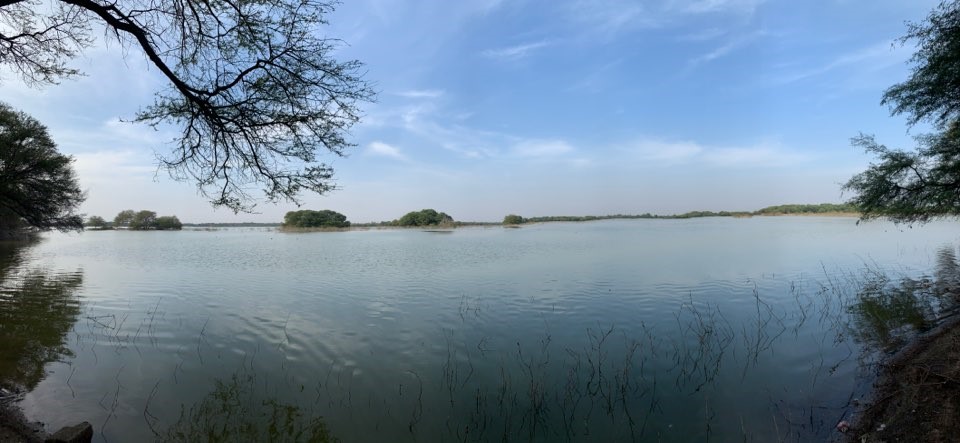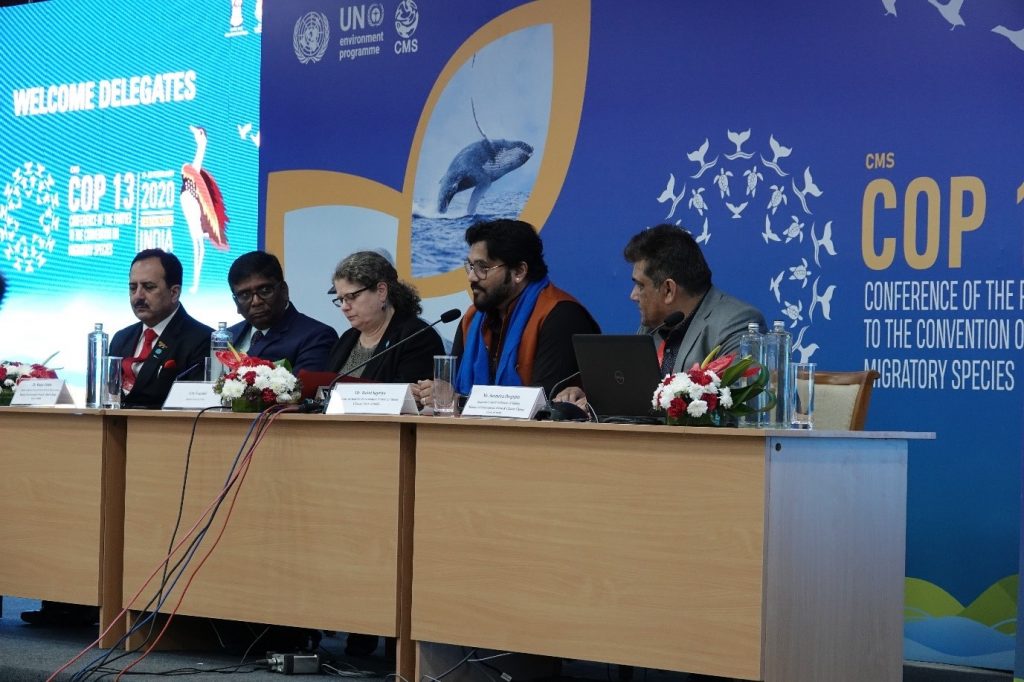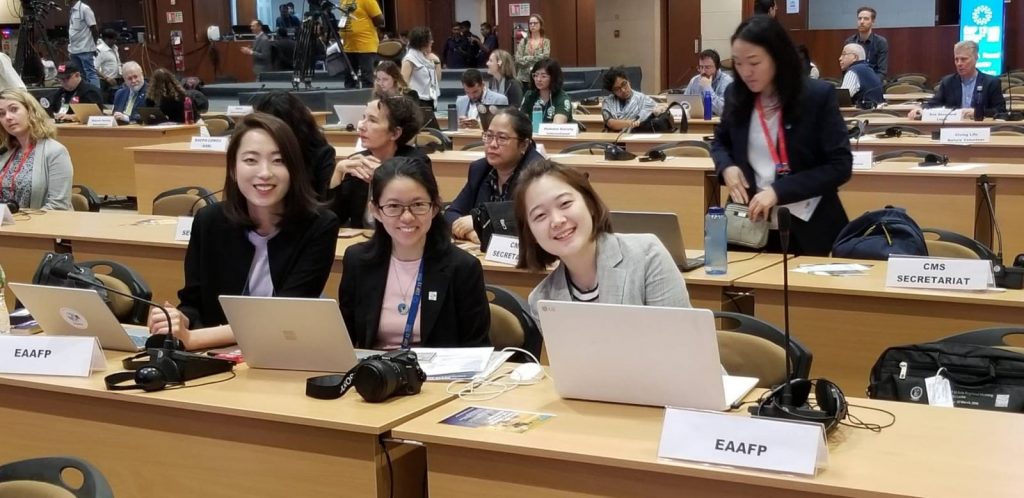Convention on the Conservation of Migratory Species of Wild Animals (CMS) is one of EAAFP’s intergovernmental organization Partners and has been collaborating with EAAFP closely since the early stage when EAAFP was established. EAAFP has worked with CMS on promoting World Migratory Bird Day and developing the Species Action Plans for Black-faced Spoonbill, Spoon-billed Sandpiper, Chinese Crested Tern, Baer’s Pochard and Dalmatian Pelican.
Between 15 and 22 February 2020, the Thirteenth Meeting of Conference of the Parties to the Convention on the Conservation of Migratory Species of Wild Animals (CMS COP 13) was held in Gandhinagar, India. CMS COP13 was the most-attended COP for the Convention in history, with over 2,500 participants from Parties, non-Party countries, United Nation agencies, intergovernmental organization, international NGOs, national NGOs and media. The theme of the COP was ‘Migratory species connect the planet and together we welcome them home.’ The CMS COP13 effectively kicked off a series of international meetings related to nature in 2020 in this super year for nature and biodiversity, and several significant resolutions and decisions to conserve migratory species were adopted, contributing to the shaping of the Post-2020 Global Biodiversity Framework.
During the COP, the Gandhinagar Declaration was adopted, which called for a stronger emphasis on migratory species and its integration under the concept of ‘ecological connectivity’ in the Post-2020 Global Biodiversity Framework – a new global biodiversity strategy for the next decade, which is expected to be adopted at the UN Biodiversity Conference in October 2020. The message was sent to the negotiating session of the Open-ended Working Group on the Post-2020 Global Biodiversity Framework held in Italy between 24-29, February. In addition, ten migratory species were added to CMS Appendices, as is a number of cross-cutting policy frameworks to address threats to migratory species including1:
- Integration of biodiversity and migratory species considerations into national energy and climate policy and to promote wildlife-friendly renewable energy;
- Strengthen initiatives to combat the illegal killing, taking and trade of migratory birds;
- Mitigate the impacts of linear infrastructure such as roads and railways on migratory species;
- Address the unsustainable use of aquatic wild meat;
- Undertake a review of bycatch levels of sharks and rays, and further implement bycatch mitigation measures for marine mammals in national fishing operations;
- Deepen our understanding of the importance of animal culture and social complexity for the conservation of endangered species;
- To investigate possible trade-in CMS Appendix I species and the implications for their conservation status.
Engagement of EAAFP Partners at CMS COP13 (click [here] for details)
EAAFP Partners who attended CMS COP13 (which were Government of Mongolia, Philippines, Bangladesh, Australia and New Zealand, ASEAN Centre For Biodiversity, The Conservation of Arctic Flora and Fauna (CAFF), BirdLife International, International Crane Foundation (ICF), International Union for Conservation of Nature (IUCN), Wildlife Conservation Society (WCS), Wetlands International, World Wide Fund for Nature (WWF)) have been actively engaged through different platforms including proposing and provide inputs for the resolutions, leading in Stakeholder Dialogue and involvement in High-level Segment discussion panel, Avian Working Group and various side events.
Prior to the official start of CMS COP13, a Stake-holder Dialogue was held on 15th Feb, in which Member states, non-governmental organizations and intergovernmental organizations were convened to allow open discussion among stakeholders. Nicola Crockford from Royal Society for the Protection of Birds (BirdLife International partner), and Ward Hagemeijer from Wetlands International were in the discussion panel. On 16th Feb, the High-level Segment with Ministers and several intergovernmental organizations and multilateral environmental agreements such as CMS, CBD, Ramsar Convention on Wetlands and ASEAN Centre For Biodiversity (ACB) was organized to discuss priorities for migratory species conservation in the Post-2020 Global Biodiversity Frame. Dr. Theresa Mundita Lim, Executive Director of ACB emphasized the work in ASEAN countries and Martha Rojas Urrego, Ramsar Convention on Wetlands, emphasized the importance of preserving wetlands to support migratory species.
The Committee of the Whole (Plenary)
The CMS COP13 started off with opening welcoming addresses, including His Excellency Narendra Modi, Prime Minister of India. In his Outgoing COP presidency statement by the Philippines, Ramon Bagatsing Jr., Ambassador of the Philippines to India, highlighted EAAFP’S contribution to promoting the conservation of migratory waterbirds in the EAAF.
There were a number of agenda items directly relevant to the work of the EAAFP. The most relevant resolutions and documents are as follows: Progress in the implementation of the Strategic Plan for Migratory Species 2015-2023 (Doc.14.1)
- Options for a follow-up to the Strategic Plan for Migratory Species 2015-2023 (14.2)
- CMS Contribution to the post-2020 Biodiversity Framework ( 17)
- World Migratory Bird Day (18.2)
- Review of the Conservation Status of Migratory Species (24)
- Illegal Killing, Taking and Trade of Migratory Birds (26.1.1) – EAAFP mentioned
- Flyways (26.1.4) – EAAFP mentioned
- Action Plans for Birds (26.1.5) – EAAFP mentioned
- Bycatch (26.2.3)
- Prevention of Bird Poisoning (26.1.3) – EAAF mentioned
- Improving Ways of Addressing Connectivity in the Conservation of Migratory Species (26.4.4)
- Transfrontier Conservation Areas for Migratory Species ( 26.4.5) – EAAFP mentioned
- Impacts of Plastic Pollution on Aquatic, Terrestrial and Avian Species ( 26.4.7)
- Climate Change and Migratory Species ( 26.4.8) – EAAF mentioned
- Light Pollution Guidelines for Wildlife including Marine Turtles, Seabirds and Migratory Shorebirds ( 26.4.9.1). – Proposed by Australian Government (press release)
- National Report from Australia
- National Report from New Zealand
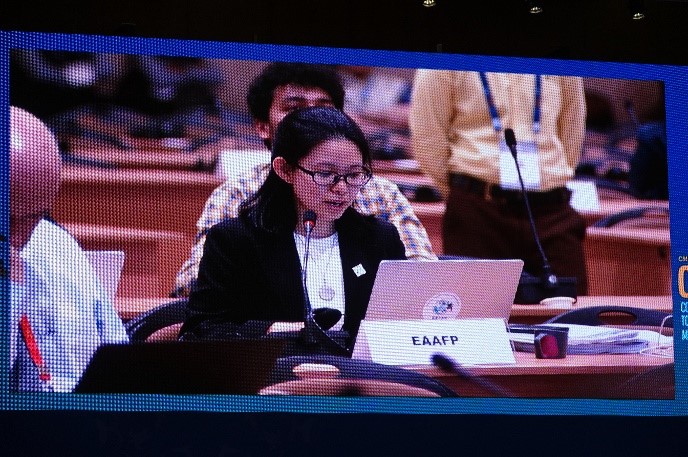 |
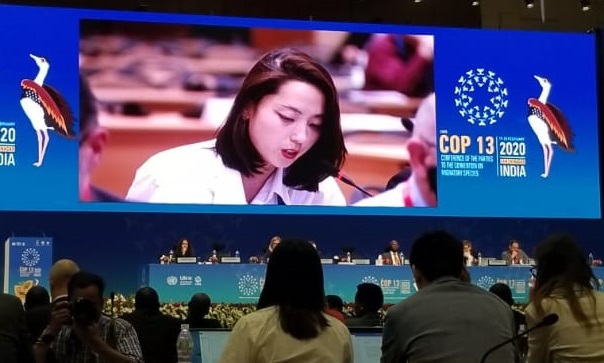 |
EAAFP Secretariat made two interventions during CMS COP13 © EAAFP
EAAFP Partners and the Secretariat made a number of interventions on key agenda items or deliver messages relevant to migratory bird conservation during the plenary. The Secretariat made interventions on the resolutions on ‘World Migratory Bird Day (WMBD)’ and ‘Flyways’ respectively, to strengthen promotion and participation on WMBD twice a year in EAA Flyway and closer cooperation with the CMS Secretariat
One important result of the COP was that the Indian Government announced the establishment of a new institutional framework focused on the conservation and research of migratory birds and associated issues, as well as a National Action Plan for the Central Asian Flyway (CAF). India also expressed its readiness to facilitate the engagement of other countries along this critical Flyway, which shares a number of species with the East Asian-Australasian Flyway.
Side Events
Various side events filled the time between and after the plenary session. This was the time when Party states, non-governmental organizations and intergovernmental organizations engaged in discussions on broad issues of importance to migratory species such as Ecological Connectivity, Climate Change, Illegal Hunting, Renewable Energy, with the different stakeholders. EAAFP Partners engaged in approximately 16 events (link), and the Secretariat was invited to present at the side event ”Beyond Ecologically Connectivity: Building a Network of Sites, People and Institutions”, organized by International Crane Foundation (ICF) and IUCN. Additionally, the EAAFP Task Force on Illegal Hunting, Taking and Trade of Migratory Waterbirds was officially introduced by Dr. Mark Carey, representing the Government of Australia as the Vice-chair of the task force during the side event “Towards eradication of illegal killing, taking and trade of wild birds” convened by BirdLife International, CMS and CAFF/AMBI. Other side events organized by or involved EAAFP Partners are as follows:
17th Feb, 2020:
- ‘A Call for Global Species Conservation Action in the post-2020 Global Biodiversity Framework’ by IUCN
- ‘Bridging Information of Wetlands and Waterbirds – Wetlands International-GIZ’ by Wetlands International (WI) South Office Asia
18th Feb, 2020:
- ‘Generating Actionable Knowledge for the Effective Protection of Marine Migratory Species’ by BirdLife International (BirdLife)
- ‘Safeguarding connectivity: from bird data to management tools’ by WI and BirdLife
- ‘Beyond Ecologically Connectivity: Building a Network of Sites, People and Institutions’ by ICF, EAAFP, IUCN WCPA CCSG
- ‘Reducing impacts of poison on migratory birds from agricultural chemicals and poison baits’ by ICF
- ‘The Road Ahead: Toyota and the IUCN Red List of Threatened Species towards the post-2020 Global Biodiversity Framework’ by IUCN
- ‘Climate Change Adaptation: How can migratory species survive?’ by CMS
- ‘Conservation of the Black-necked Crane: current status and possible courses of action’ by ICF, BirdLife, WWF International
19th Feb, 2020
- ‘Migratory species and ecological connectivity: opportunities for cross-boundary collaboration through the emerging UN Ocean Treaty’ by BirdLife
- ‘Towards eradication of illegal killing, taking and trade of wild birds’ by CMS, AMBI/CAFF, BirdLife
- ‘Connecting Wetlands and Migratory Species: Connectivity and the post-2020 Global Biodiversity Framework’ by Ramsar, CMS
- ‘India and the Arctic Migratory Birds Initiative (AMBI): for the Conservation of Threatened Arctic Breeding Shorebirds Wintering in India’ by CAFF/AMBI, jointly with Ministry of Environment, Forest, and Climate Change (India), the Ministry of Earth Sciences (India) and the Bombay Natural History Society (BNHS)
20th Feb, 2020
- ‘Connected energy solutions for a connected world: rapidly reconciling renewable energy investment with biodiversity conservation’ by BirdLife
- ‘Addressing the Impact of Linear Infrastructure on Migratory Species’ by CMS
- ‘Using sensitivity mapping to avoid conflict between birds and renewable energy infrastructure in India and Asia’ by BirdLife
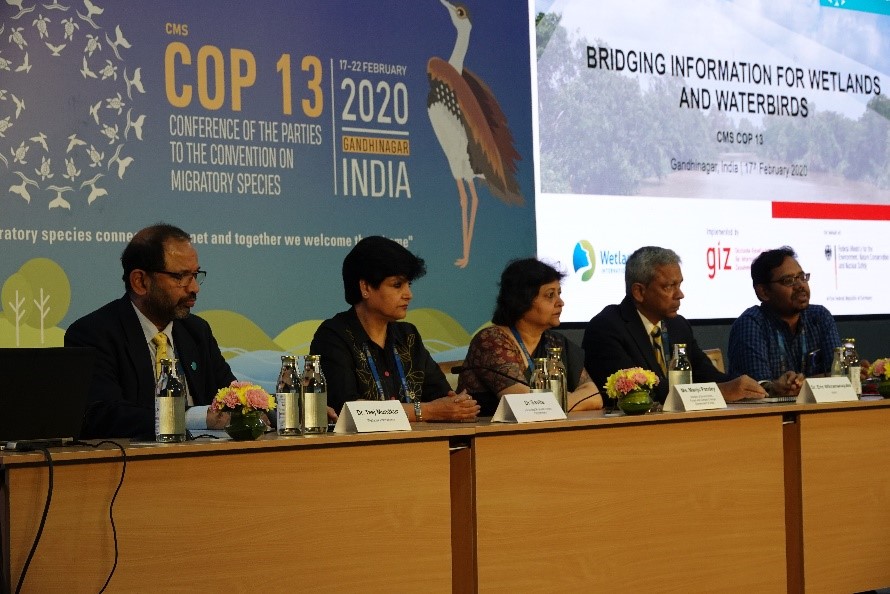 |
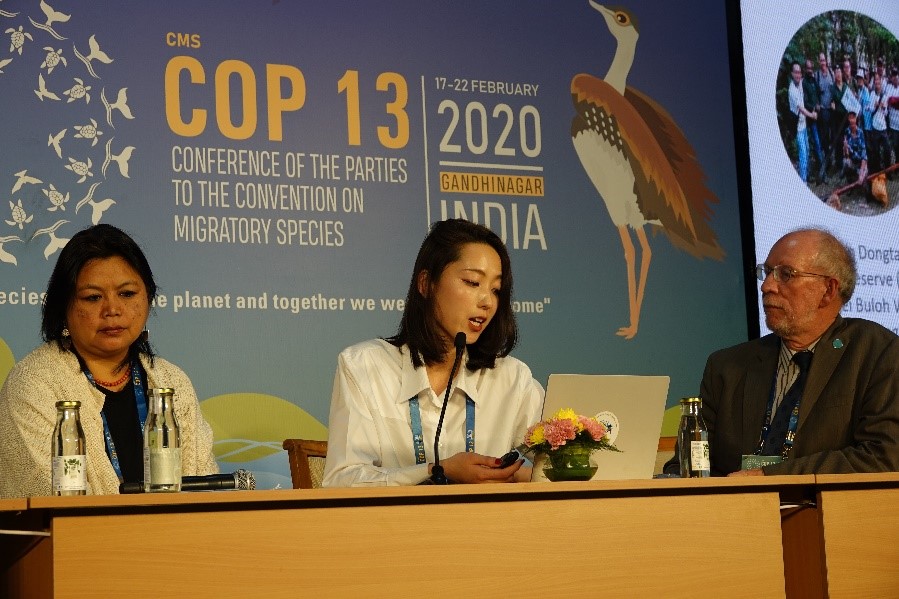 |
© EAAFP
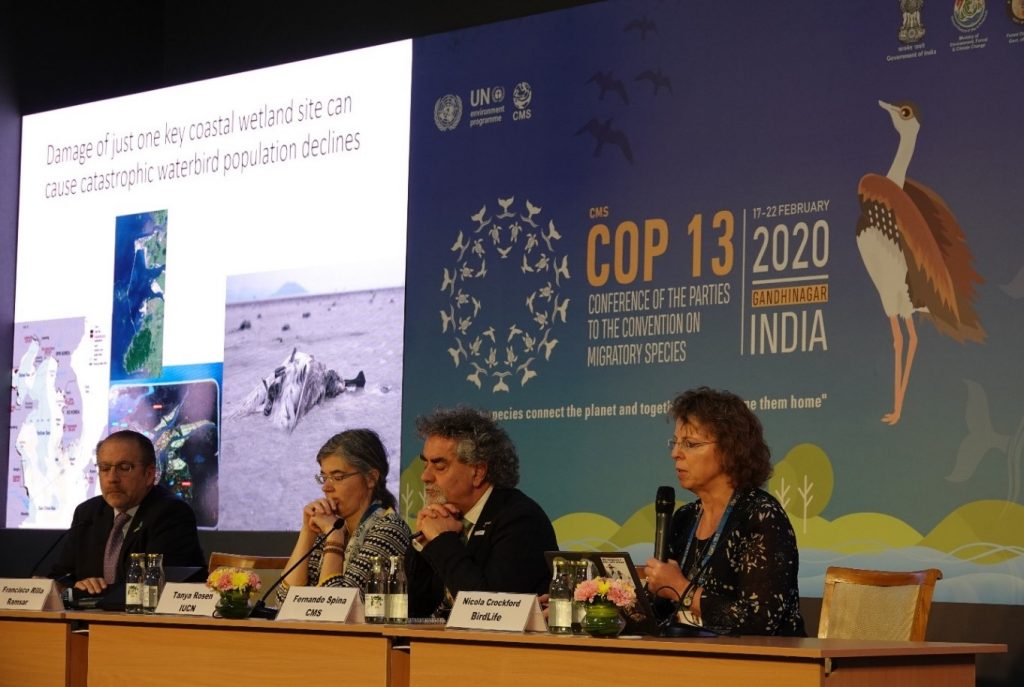 |
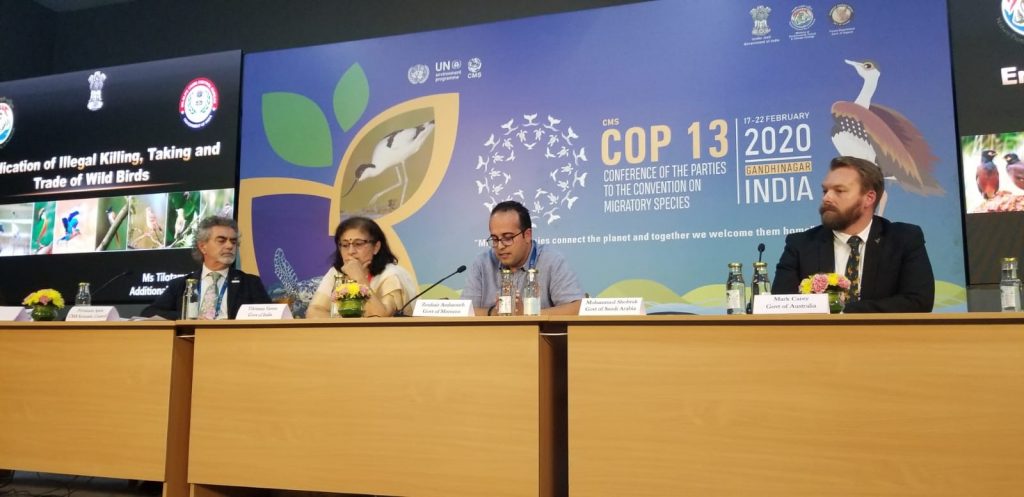 |
© EAAFP
Exhibitions and special side events
In addition to the busy schedule of CMS COP13, there were exhibitions and special side events, where COP participants could display and promote their conservation work. Our Partners from BirdLife International and the ASEAN Centre for Biodiversity organized exhibition booths and interacted with COP participants. Presentations, film screenings and even puppet show were enjoyed by local and international audience during the conference.
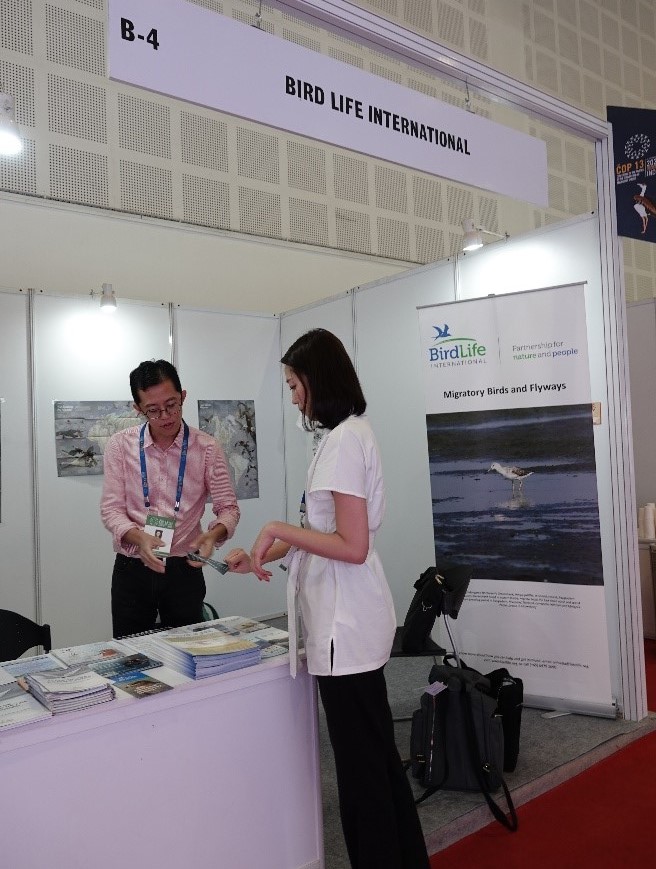 |
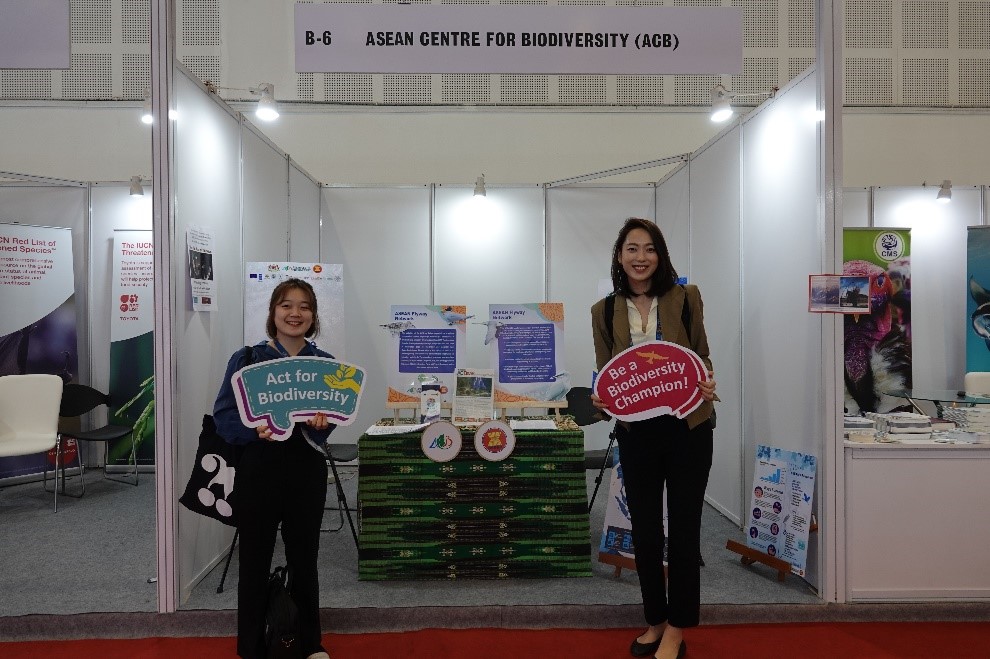 |
Booths by BirdLife International and ASEAN Centre For Biodiversity © EAAFP
Summary
On 22nd Feb 2020, the CMS COP concluded with 10 new migratory species included in the CMS Appendices, adopted Concerted Actions for 14 species, convened the first ever report on the Status of Migratory Species, seven resolutions of cross-cutting policy measures to address threats to migratory species, three CMS Ambassadors for terrestrial, avian and aquatic species, seven Migratory Species Champions, as well as new Agreements and MoUs benefiting and fostering conservation of migratory species. The Gandhinagar Declaration adopted during the COP agreed on important steps moving forward to conserve migratory species to be delivered for developing the Post-2020 Global Biodiversity Framework. The EAAFP will continue to work with partners to implement actions to conserve migratory waterbirds in East Asian-Australasian Flyway and continue to contribute in the coming important international events to develop the Post-2020 Global Biodiversity Framework.
Epilogue (by Ms. Jiyae Yim, Programme Assistant)
“As one of the Youth who is dreaming to be a conservationist, thankfully, it was a huge opportunity to see the discussion and catch up a process of the Post-2020 global biodiversity framework agenda. Meanwhile, it also felt sorry that there was no apparent youth engagement during the session or any side event, even though they need to take the leading role on this conversation in upcoming years. With many prioritizing agendas, I hope this issue can be raised in the next CMS COP or at the other global conservation events and I wish to be there either!“
Other information
Photos: Click [here] for photos of EAAFP at CMS COP13.
Official press releases and news from CMS and IISD:
- CMS COP13 News Room: https://www.cms.int/en/news/cms-cop13-concludes-india-major-new-actions-migratory-species
- Highlights of 16 Feb 2020(from IISD): https://enb.iisd.org/download/pdf/enb1878e.pdf
- Highlights of 17 Feb 2020(from CMS Secretariat): https://www.cms.int/en/news/cms-cop13-opening-press-release-major-un-meeting-wildlife-address-critical-threats-migratory
- Highlights of 17 Feb 2020(from IISD): https://enb.iisd.org/download/pdf/enb1879e.pdf
- Highlights of 18 Feb 2020(from IISD): https://enb.iisd.org/download/pdf/enb1880e.pdf
- Highlights of 19 Feb 2020(form IISD): https://enb.iisd.org/download/pdf/enb1881e.pdf
- Highlights of 20 Feb 2020(from IISD): https://enb.iisd.org/cms/cop13/20feb.html
- Conclusion(from IISD, CMS Secretariat): https://enb.iisd.org/cms/cop13/, https://www.cms.int/en/news/cms-cop13-concludes-india-major-new-actions-migratory-species
EAAFP social media releases:
- EAAFP webpage (EAAFP Partners Engagement at CMS COP13): https://www.eaaflyway.net/information-of-eaafp-partners-engagement-at-cms-cop13/?fbclid=IwAR0_q1J3gEsopQETKGHPZQNwHBzsbnsR50Tbevi7xqrnOS4UFd088FztNjA
- CMS COP13 High-level Segment Meeting(16/02/20): https://www.facebook.com/eaafp/posts/2905529636174188
- CMS COP13 EAAFP Partners Group photo (17/02/20): https://www.facebook.com/eaafp/photos/a.306177876109390/2906693729391112/?type=3&theater
- Side event ‘Towards eradication of illegal killing, taking and trade of wild birds’ (18/02/20): https://www.facebook.com/eaafp/posts/2910750545652097, https://www.facebook.com/eaafp/posts/2912819532111865, https://www.facebook.com/eaafp/videos/615360765953961/
- Action Plans for Birds (18/02/20): https://www.facebook.com/eaafp/posts/2908357165891435
- Resolution intervention from our Partners (19/02/20): https://www.facebook.com/eaafp/posts/2909945259065959, https://www.facebook.com/eaafp/posts/2910621175665034

